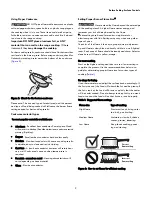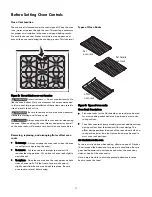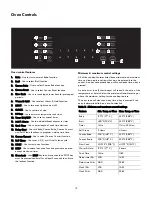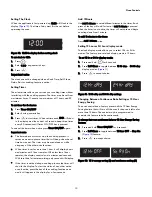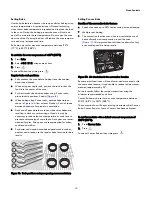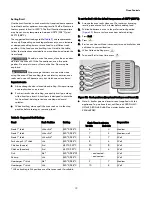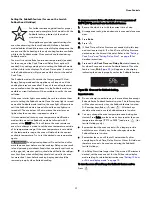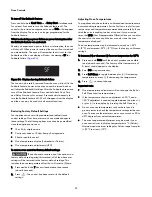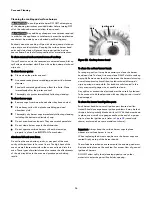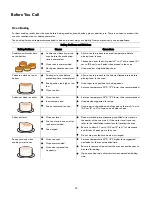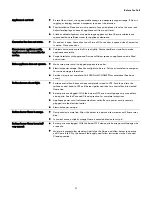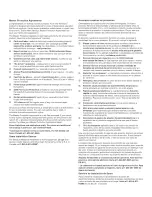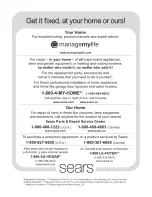
23
Oven Controls
Self Clean
A self cleaning oven cleans with very high temperatures well
above normal cooking temperatures. The high temperature elim-
inates soils completely or reduces them to a fine powdered ash
you can wipe away afterwards with a damp cloth.
The Self Clean function allows you to set a cleaning time from 2
hours to 4 hours. A 3 hour cleaning time is recommended for
normal cleaning, 2 hours for light cleaning, and 4 hours for
heavy cleaning.
Read before starting Self Clean:
Do not leave small children unattended near
the appliance. During the self cleaning cycle, the outside of the
oven can become very hot to touch and can cause burns.
Do not line the oven walls, racks, bottom or any other part of the
oven with aluminum foil. Doing so will destroy heat distribution,
produce poor baking results and cause permanent damage to
the oven interior. Aluminum foil will melt to the interior of the
oven.
The health of some birds is extremely sensitive to the fumes
given off during the self cleaning cycle of any oven. Move birds
to another well-ventilated room.
Do not force the door open. This can damage
the automatic door locking system. Use caution when opening
the oven door after self cleaning. The oven may still be very hot
and can cause burns. To avoid possible burns stand to the side
of the oven when opening the oven door to allow hot air or
steam to escape.
Important note:
Completely remove all oven racks and any accessories from
oven cavity to avoid damage to oven racks. If the oven racks
are not removed they may discolor.
•
Remove all items from the oven including bakeware, utensils
and any aluminum foil. Aluminum foil will not withstand
high temperatures from a self clean cycle and will melt.
•
Do not use oven cleaners or oven protective coatings in or
around any part of the oven interior.
•
Clean any soil from the oven frame, the door liner outside
the oven door gasket and the small area at the front center
of the oven bottom (
Figure 25
). These areas heat sufficiently
to burn soil on. Clean using soap and water prior to starting
Self Clean.
•
Do not clean the oven door gasket (
Figure 25
). The woven
material of the oven door gasket is essential for a good
seal. Care should be taken not to rub, damage or remove
the gasket. Do not use any cleaning materials on the oven
door gasket. Doing so could cause damage to the door
gasket.
•
Remove any excessive build up caused by spills. Any spill on
the oven bottom should be wiped up and removed before
starting a self clean cycle. To clean, use hot, soapy water
and a cloth. Large spill residue can cause heavy smoke or
fire when subjected to high temperatures. Do not allow food
spills with a high sugar or acid content (such as milk,
tomatoes, sauerkraut, fruit juices or pie filling) to remain on
the surface as they may leave a dull spot even after
cleaning.
To set self clean:
1.
Be sure the oven is empty and all oven racks are removed.
Remove all items from the oven. Be sure oven door is
completely closed.
2. Press
Self Clean
and the default 3 hour clean time will
appear in the display. You may accept the default 3 hour
clean time by going to step 3, or choose a different clean
time. Press Self Clean and use the numeric keys to select
any time between 2 hours and 4 hours. Once you have the
desired clean time selected proceed to step 3.
3. Press
to activate Self Clean. As soon as Self Clean
becomes active, a motor driven lock mechanism will begin
locking the oven door automatically and door Loc will
appear in the display (
Figure 26
on page 24). Do not open
the oven door when door Loc is displayed (allow 15 seconds
for the lock mechanism to lock the oven).
Once the oven door has locked, CLn will appear in the display
indicating Self Clean has started.
Important note: Do not force the oven door open when self-
clean is active. This can damage the automatic door-locking
system. Use caution when opening the door after self-clean
cycle is complete; the oven may still be very hot.
Figure 25: Oven door area to clean and not clean (gasket).

